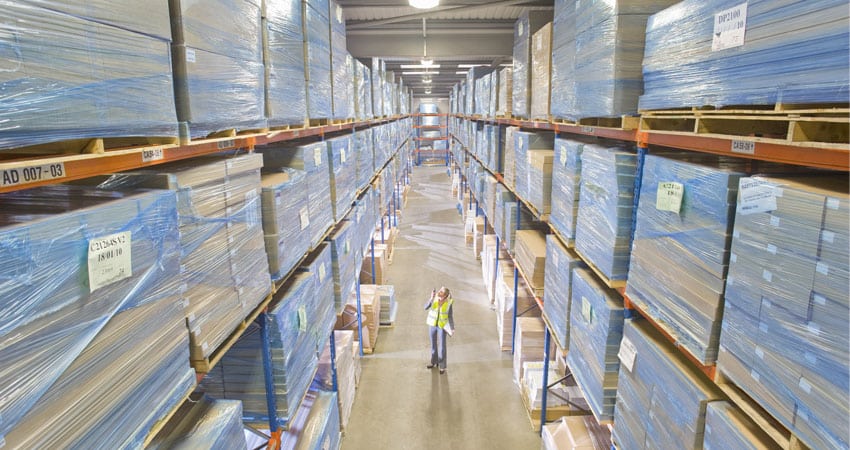As we evaluate multichannel warehouse operations, we are commonly asked, “When is a warehouse at capacity?” We find when that between 80% and 85% of space utilization, efficiency typically drops from a movement and storage perspective. Pallet movement becomes very restricted and each move and replenishment may take multiple actions to complete.
Temporary floor pallet positions may also restrict aisle movement. Multiple moves increase costs and slow down processing. Many businesses need to improve warehouse space utilization or find a new facility earlier than expected.
One of the first and toughest things to address is whether you can reduce space used by focusing on the age of the inventory and liquidating overstock. Should this be the first step in your fulfillment cent space study? Do you have inventory reporting that shows by SKU the weeks of supply and the inventory turnover? This will show how many weeks it will take to sell off the inventory. These are key reports when discussing space utilization with management.
Beyond the initial step of addressing potential overstock, here are 15 ways you can improve your warehouse space utilization:
The Starting Point
Quantify your storage profile in terms of capacity and utilization. Thoroughly understand the flow and utilization of the current layout, including rack configuration, slotting/pick philosophy, receiving, putaway, replenishment, inventory management and packing and shipping. Include seasonal peak trends and a thorough volume analysis of inbound and outbound product flow.
Use Your Vertical Space
Look up and make sure you’re using all the vertical space available. Investigate storage media to take advantage of your clear span height. How much cubic feet of vertical space is not being used? Be sure to know how your design might impact your sprinkler layout and fire code.
Analyze Your Department Space
Identify functions that do not require high ceilings in areas where lower stacking heights are dictated by the clear height. We often see unused overhead space where large departments like packing and shipping are performed.
Consolidate Locations
If you have multiple locations for storing the same item, consider combining them to create better warehouse space utilization. This can be done during the putaway process and as a standalone function.
Right-Size Your Slots
Match the size and sales of the item to the right sized pick slot to maximize the utilization of the picking slot cube. Having various sizes of picking slots can facilitate this process. The same logic applies to locations where you store reserve or overstocks. In forward picking, keep 4-7 days of sales by SKU to reduce replenishment.
Use Off-Site Location for Overstock
If you store a large quantity of excess inventory for a few items, consider some type of offsite storage for the excess, thus freeing up space for supporting the fulfillment operation.
Drop Shipping As An Option
If you store and ship large items, consider utilizing some form of drop shipping to reduce your in-house inventory and costs.
Aisle Widths
How wide are your warehouse aisles? Try to design the minimum width required to match the material handling equipment used without compromising operating efficiency.
Cross Docking
If possible, consider cross docking large releases of back orders or single-line orders to reduce the amount of inventory requiring storage locations.
Best Utilization of Your Building
Make sure you study your building to determine how it can best be utilized from a space standpoint. Consider clear stacking height, column spacing, building impediments and overall process flow. Try to match vertical space needs with the building characteristics.
Depth of Storage
Review not only the effective use of the height of locations, but also the depth of storage; for example, consider double-depth racking.
Supply Storage
If you have to store supplies or packing materials, try to manage the inventory to avoid overstocks. See if your corrugated supplier can keep some inventory at its site for you, and take delivery every few days.
Door Use
If you have separate shipping and receiving docks, consider combining them to save space.
Mezzanine Installation
If your building layout permits, consider the use of a mezzanine to house functions that do not require high-bay storage. These can be expensive and are fairly permanent, but will maximize warehouse space utilization.
Keep It Simple
Where you have a choice between a complex and simple solution, choose the simple solution. For example, consider adding pallet rack tiers upward. An example of complexity could be moving racking to narrow aisles. Is there a return on investment for your solutions?
Warehouse space often represents 15% to 20% of the cost per order. Moving to new space is expensive and takes a lot of time. Make sure you have assigned someone responsible for your ongoing planning and warehouse space utilization analysis process.
[Note: this originally published in 2017 and has been updated.]
Brian Barry is president of F. Curtis Barry & Company

